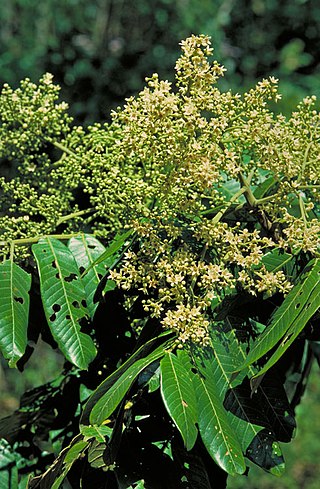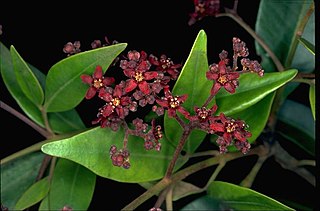
Flindersia is a genus of 17 species of small to large trees in the family Rutaceae. They have simple or pinnate leaves, flowers arranged in panicles at or near the ends of branchlets and fruit that is a woody capsule containing winged seeds. They grow naturally in Australia, the Moluccas, New Guinea and New Caledonia.

Flindersia ifflana, commonly known as hickory ash or Cairns hickory, is a species of tree in the family Rutaceae and is native to Papua New Guinea and Queensland. It has pinnate leaves with between four and twelve egg-shaped to elliptical leaflets, panicles of white or cream-coloured flowers and woody fruit studded with rough points.

Flindersia pimenteliana, commonly known as maple silkwood, red beech or rose silkwood, is a species of tree in the family Rutaceae and is native to New Guinea and Queensland. It has pinnate leaves with three to seven egg-shaped to elliptic leaflets, panicles of red or reddish flowers and fruit studded with rough points.

Flindersia schottiana, commonly known as bumpy ash, cudgerie or silver ash, is a species of rainforest tree in the family Rutaceae and is native to New Guinea and eastern Australia. It has pinnate leaves with mostly ten to sixteen leaflets, panicles of white flowers and woody fruit studded with rough points.

Flindersia brayleyana, commonly known as Queensland maple, maple silkwood or red beech, is a species of tree in the family Rutaceae and is endemic to northern Queensland. It has pinnate leaves with between six and ten leaflets, panicles of white or cream-coloured flowers and smooth fruit that opens in five sections to release winged seeds.

Flindersia australis, commonly known as crow's ash, flindosy or Australian teak, is a species of tree that is endemic to north-eastern Australia. It has pinnate leaves with between five and thirteen egg-shaped to elliptical leaflets, white to cream-coloured flowers arranged in panicles on the ends of branchlets and followed by woody capsules studded with short, rough points and containing winged seeds.

Flindersia maculosa, commonly known as leopardwood or leopard tree, is a species of tree in the family Rutaceae and is endemic to inland areas of eastern Australia. It has mottled bark, simple leaves arranged in opposite pairs, white to cream-coloured flowers and fruit studded with rough points.

Flindersia collina, commonly known as broad-leaved leopard tree, leopard ash, bastard crow's ash or leatherwood, is a species of tree in the family Rutaceae and is endemic to north-eastern Australia. It usually has pinnate leaves with between three and seven elliptical to spatula-shaped leaves, panicles of white flowers and fruit studded with rough points.

Flindersia xanthoxyla, commonly known as yellowwood, long jack or yellowwood ash, is a species of rainforest tree that is endemic to eastern Australia. It has pinnate leaves arranged in opposite pairs with seven to eleven leaflets, panicles of yellow flowers and woody fruit studded with rough points on the surface.

Flindersia bennettii, commonly known as Bennett's ash, is a species of tree in the family Rutaceae and is endemic to north-eastern Australia. It has pinnate leaves with between three and nine leaflets, cream-coloured flowers arranged on the ends of branchlets and woody fruit containing winged seeds.

Bosistoa pentacocca, commonly known as ferny-leaf bosistoa, native almond or union nut, is a species of tree that is endemic to eastern Australia. It has pinnate leaves arranged in opposite pairs with between three and thirteen leaflets and panicles of small flowers arranged in leaf axils or on the ends of branches. It grows along streams in rainforest.

Melicope bonwickii, commonly known as the yellow evodia or yellow corkwood, is a species of tree in the family Rutaceae and is native to Java and the Philippines, and southward to New Guinea and north-eastern Australia. It has trifoliate leaves and small pink flowers borne in panicles in leaf axils.

Zanthoxylum rhetsa, commonly known as Indian prickly ash, is a species of flowering plant in the family Rutaceae and occurs from India east to the Philippines and south to northern Australia. It is a deciduous shrub or tree with cone-shaped spines on the stems, pinnate leaves with between nine and twenty-three leaflets, panicles of white or yellowish, male and female flowers, followed by spherical red, brown or black follicles.

Flindersia acuminata, commonly known as silver silkwood, icewood, Putt's pine, Paddy King's beech or silver maple, is a species of tree that has pinnate leaves with between six and ten egg-shaped to elliptic leaflets, creamy yellow flowers arranged in panicles, and fruit studded with short, rough points.

Flindersia bourjotiana, commonly known as Queensland silver ash, northern silver ash, or white ash, is a species of tree that is endemic to Queensland. It has pinnate leaves arranged in opposite pairs and with between four and eight narrow egg-shaped to elliptic leaflets, greenish white flowers arranged in panicles, and fruit studded with short, rough points.

Flindersia brassii, commonly known as hard scented maple or Claudie River scented maple, is a species of tree that is endemic to Queensland. It has pinnate leaves with between four and nine narrow elliptical leaflets, white or cream-coloured flowers arranged in panicles, and fruit studded with rough points.

Flindersia dissosperma, commonly known as scrub leopardwood, is a species of small tree in the family Rutaceae and is endemic to eastern-central Queensland. It usually has pinnate leaves with between three and five elliptical to egg-shaped leaves, panicles of white to cream-coloured flowers and fruit studded with rough points.

Flindersia oppositifolia, commonly known as mountain silkwood, is a species of tree that is endemic to the Bellenden Ker Range in northern Queensland. It has simple leaves arranged more or less in opposite pairs, dark reddish flowers arranged in panicles, and fruit studded with short, rough points.
Medicosma heterophylla is a species of small tree in the family Rutaceae and is endemic to a restricted area of far north Queensland. It has simple and trifoliate, elliptical leaves and leaflets, and cream-coloured to pink or reddish flowers borne singly or in small groups in leaf axils.
Melicope peninsularis is a species of small tree in the family Rutaceae and is endemic to tropical north Queensland. It has trifoliate leaves and white flowers borne in short panicles in leaf axils.
















